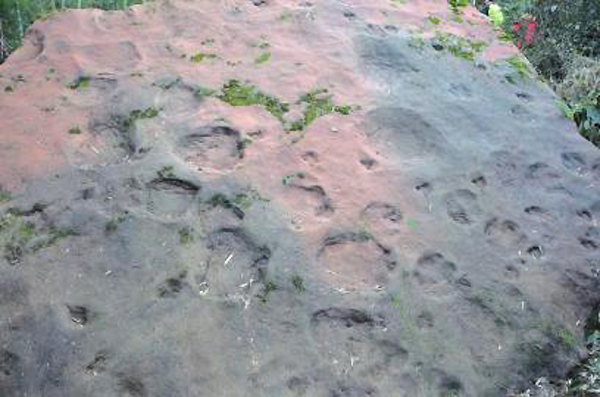 |
|
Dromaeosaur footprints found in Gulin county, Sichuan province.[Photo by Xing Lida/China Daily] |
The latest dromaeosaur footprints found in Gulin county, Sichuan province, show that these dinosaurs might have acted alone sometimes, instead of hunting in groups.
About 100 million years ago, after a heavy meal, these aggressive hunters left a set of messy footprints on a 7 square meter piece of land.
After they left, the prints were baked by the sun before becoming buried under sand and mud, helping to preserve seven groups of 7-to 9-cm-long prints to the present day.
Xing Lida, a PhD candidate at the School of Earth Sciences and Resources at China University of Geosciences in Beijing, arrived at the excavation site soon after residents reported the findings to him.
"With a body size no larger than that of a sheep, the dromaeosaurs' footprints are hard to preserve because they are too shallow, which makes them weather away easily," Xing said.
In July, Gulin residents found a 69-meter-long track composed of about 80 dinosaur footprints, which later proved to be the longest track of predatory dinosaur footprints found in East Asia.
After this, the residents searched meticulously for dinosaur prints before finding the new site in a forest 3 km from the track.
"The footprints can provide us with more information about the Cretaceous dinosaurs that lived 100 million years ago, because well-kept dinosaur bones from this period are rare," Xing said.
"Based on these newly unearthed prints, we can see that dromaeosaur may sometimes have acted alone, different from our previous understanding," he said.
Further research will be carried out after experts take the prints to laboratories.
This is the sixth dromaeosaur footprint site found in China, following two in Shandong province, one in Sichuan, one in Gansu and one in Hebei.
"Worldwide, there are only a dozen footprint fossils of this kind, as it is so difficult to discover the prints of such small dinosaurs," Xing said.
Peng Guangzhao, deputy director of the Zigong Dinosaur Museum in Sichuan, suggested that the local government build a museum and geological park to protect the footprints.
